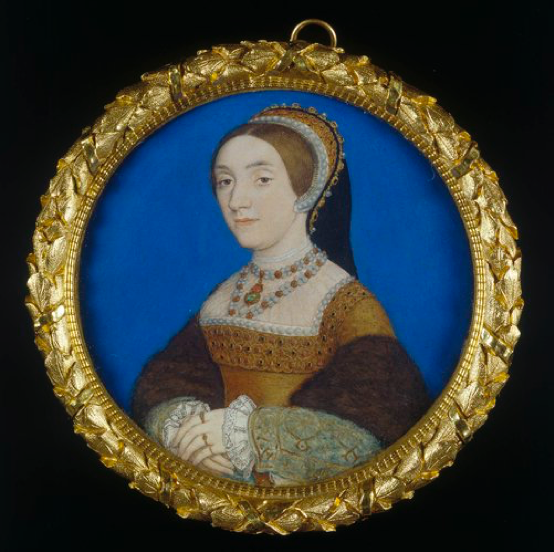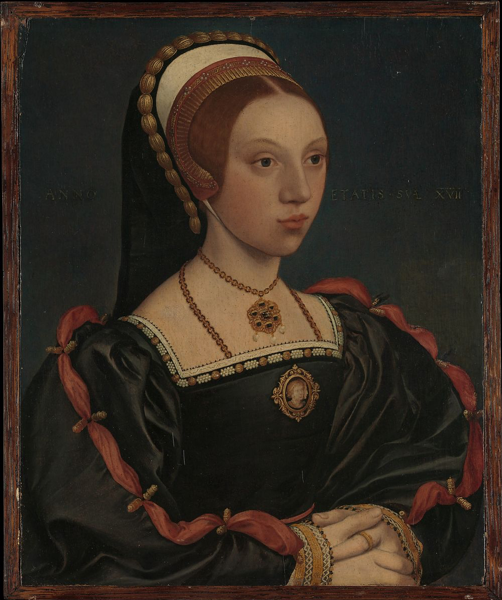Katherine was queen of England for only sixteen months, from her marriage to Henry VIII in July 1540 to her disgrace in November 1541. This was a very short period of time in which her portrait might have been painted, and yet her predecessor Jane Seymour, who was third consort to Henry VIII and was queen of England for a similarly short period, was certainly painted by Holbein in 1536-7. At least one Holbein portrait has traditionally been identified as an image of Katherine, but almost certainly incorrectly.
It is highly likely that a miniature in the Royal Collection, dated to 1540, portrays Katherine. It was identified by Dr David Starkey as a likeness of the queen, on the basis that the sitter wears jewellery that belonged to the queens of England. Clearly, the portrait represents neither Jane Seymour nor Anne of Cleves. Starkey argued that the portrait was painted shortly after Katherine’s wedding in the summer of 1540. It has been argued, however, that the portrait actually depicts Henry VIII’s niece, Margaret Douglas. This argument has not received a great deal of support from modern historians, most of whom believe that the miniature is a portrait of Henry VIII’s fifth wife. There is less evidence for the portrait’s identification as Margaret Douglas than there is for the traditional argument that it depicts Queen Katherine. It is possible that the miniature is the only contemporary portrait of Katherine.

Portrait of a Lady, perhaps Katherine Howard. c. 1540, Royal Collection Trust.
In my book “Katherine Howard: Henry VIII’s Slandered Queen”, I suggest that a portrait housed in the Metropolitan Museum of Art in New York, which dates to c. 1540-5, may be a likeness of Katherine. The Metropolitan Museum of Art states on its website that ‘The style of this young woman’s sumptuous attire indicates that she was most likely a member of the English royal court from about 1540–47, during the time of Catherine Howard and Catherine Parr.’ The sitter wears beautiful French costume and is sixteen years of age; historians such as Susan James have speculated that the portrait represents Katherine. Certainly, it is unlikely that it represents another Englishwoman at court, such as one of the queen’s maidens, for few of her attendants would have been of high enough birth to wear such lavish costume, and none of the other royal women at court in this period – including Mary Tudor, Margaret Douglas, Frances Brandon and Eleanor Brandon – were aged sixteen in 1540-45. It is possible, although unproven, that the portrait represents Katherine, but further research needs to be undertaken before the portrait can be identified as her.

Portrait of a Young Woman. c. 1540-45, Metropolitan Museum of Art, New York.
Finally, a portrait housed in the Toledo Museum of Art attributed to Hans Holbein the Younger, with versions at the National Portrait Gallery in London and at Hever Castle, has often been labelled as a likeness of Katherine. The portrait has been dated to 1535-40, meaning that it is entirely possible that it was created some years prior to Katherine’s marriage to Henry VIII. The sitter is aged in her twenty-first year, and her beautiful dress proclaims her high social standing. The portrait belonged to the Cromwell family, which calls into question its identification as an image of Katherine, for her marriage to the king occurred on the very day that Thomas Cromwell was executed and her family were identified in contemporary rumour as at least partly responsible for his downfall. It has been more plausibly suggested that the portrait depicts Elizabeth Cromwell, younger sister of Jane Seymour, or a niece of Henry VIII, perhaps Frances Brandon or Margaret Douglas. A persuasive argument has been made by several historians for the Holbein portrait sitter’s identification as Elizabeth Cromwell, younger sister of Queen Jane, and the portrait may have been commissioned in 1537 shortly after Elizabeth married Gregory, son of Thomas Cromwell, when Thomas was himself in high favour with the king and in a position to commission a portrait of his daughter-in-law. The Toledo Museum of Art states on its website that ‘the painting belonged to the Cromwells for centuries, so she [the sitter] was probably a member of that prominent family.’ As has already been noted, the sitter in the Holbein portrait was aged in her twenty-first year when she sat for the portrait. Given that Katherine Howard was born between 1523 and 1525, she never reached the age of twenty-one, and so logic would suggest that she could not be the sitter in the portrait.

Portrait of a Lady, probably a Member of the Cromwell Family. Hans Holbein the Younger, 1535-40, Toledo Museum of Art.
It is possible, therefore, that a portrait of Katherine Howard was created during her brief queenship in 1540-1. Several portraits have been identified over the centuries as likenesses of her, but none of them can be conclusively proven to be authentic images of Katherine. The miniature in the Royal Collection Trust is the identification most likely to be accurate. It was probably painted shortly after Katherine’s marriage to the king, or sometime in 1540. It is possible, but unproven, that a portrait in the Metropolitan Museum of Art in New York painted in c. 1540-5 depicts the queen. Finally, it is highly unlikely that the Toledo portrait – with versions at the National Portrait Gallery and at Hever Castle – is a likeness of Queen Katherine, despite the fact that its identification with the queen has proven enduring since the nineteenth-century. It is more likely to represent Jane Seymour’s sister Elizabeth Cromwell, or perhaps a niece of Henry VIII.
About the Author
Conor studied at the universities of Exeter and York. He is the author of Katherine Howard: Henry VIII’s Slandered Queen and Queenship in England. Since 2012 he has run a historical blog and was formerly editor of Tudor Life Magazine. His research interests lie in late medieval and Tudor queenship.
















Latest Comments